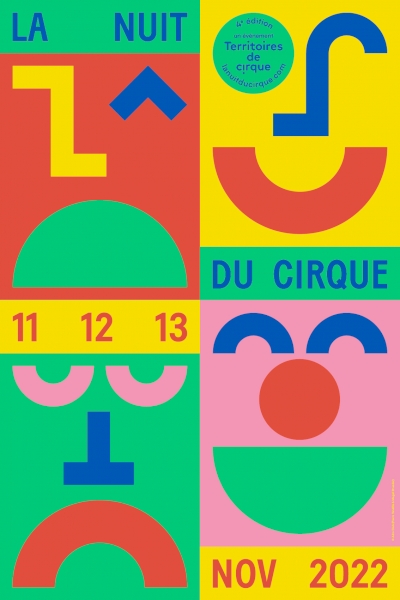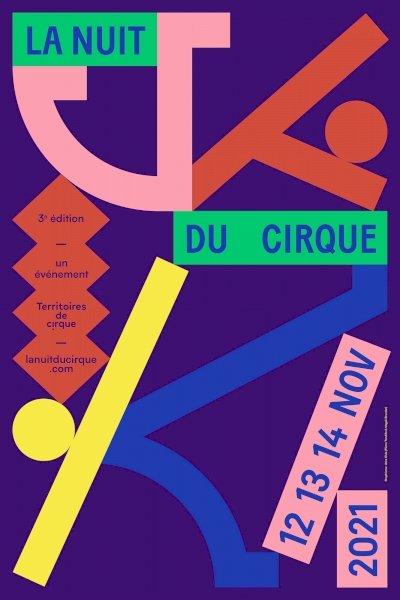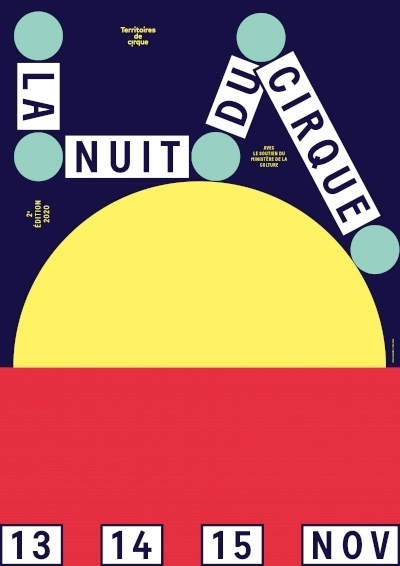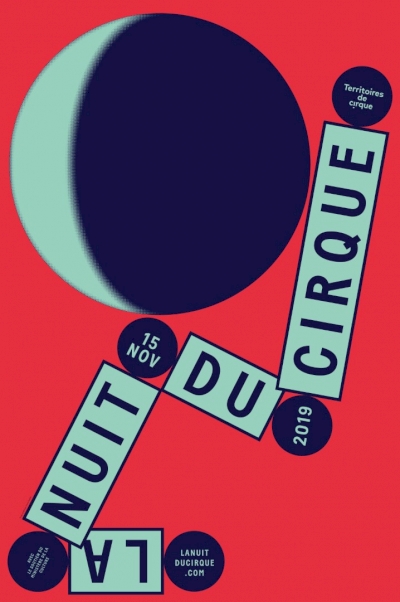Event

Created in 2019, La Nuit du Cirque is a major cultural event that celebrates all facets of the contemporary circus across France and around the world.
This unifying and festive moment takes place every autumn in order to share the vitality and diversity of this resolutely popular and demanding art form. La Nuit du Cirque is dedicated to promoting the social and environmental commitments of the contemporary circus as well as its intercultural and intergenerational dimensions.
It is a snapshot of the diversity of circus creation at any given moment, that tells the story of an art form in permanent evolution and fully open to the major issues that are being debated in society.
La Nuit du Cirque is an international event to promote contemporary circus creation, initiated and organized by Territoires de Cirque with the support of the French Ministry of Culture, in collaboration with the Institut Français and assistance from Circostrada, circusnext, ProCirque (Switzerland), BUZZ (Germany), the FFEC - French Federation of Circus Schools, the FEDEC - European Federation of Professional Circus Schools and the Grand CIEL network.
La Nuit du Cirque as seen by Rima Abdul Malak
Created in 2019, La Nuit du Cirque has become a not-to-be-missed event that showcases the vitality and diversity of the contemporary circus to an ever-widening audience.
This event is part of the French Ministry of Culture’s policy of supporting circus creation throughout the country via a broad network of national circus centers certified as “Pôles Nationaux du Cirque”. This network continues to expand, most recently with Le Plongeoir - Cité du Cirque in Le Mans, which was awarded the Pôle National du Cirque label last June.
As a creative interlude in the heart of autumn, La Nuit du Cirque offers more than 250 events — shows, workshops, conferences, and screenings — in cities and across the countryside during a 72-hour period in order to highlight the diversity of the circus arts. I’m thinking, for example, of the joyous show 3D by Jonathan Guichard and his company H.M.G., which invites us to reflect on the way we occupy space, or the Complexe de l’Autruche by the Compagnie du Courcirkoui that features a high-flying collective of tightrope walkers.
I’d also like to salute the commitment to solidarity demonstrated by the 5th edition of La Nuit du Cirque. Acting as a co-producer for the first time, the Territoires de Cirque network is presenting Rêves by the Ukrainian company Inshi, which will premiere at the Théâtre Graslin in Nantes. More than a gesture of friendship to the Ukrainian people, this show reminds us of the importance of creating, performing, and resisting war through art.
I’m also delighted by the growing internationalization of this annual event, which reflects the appeal of the creative circus beyond our borders. It’s a powerful phenomenon that will help foster the mobility of both artists and their work.
In this year of Olympic spirit, La Nuit du Cirque reminds us of the strength of the collective, the ability to surpass oneself, and the need for mutual inspiration as we strive to envision a better future.
Congratulations to all the partners and participants in this latest edition! Now it’s time for the show!
Rima Abdul Malak
French Minister of Culture
A word from Territoires de Cirque
Interview with Philippe le Gal
Former president of Territoires de Cirque
Director of Le Carré Magique, National Circus Center in Brittany, France
For the 5th edition of La Nuit du Cirque, the Territoires de Cirque circus network will serve as a co-producer for the first time with the show Rêves by the Ukrainian company Inshi, which will premiere at the Théâtre Graslin in Nantes. Beyond the clear expression of solidarity that this represents, does the network see this decision as a way of giving the 5th edition a special identity?
Every year, La Nuit du Cirque brings together more and more venues, each one very different from the next: local cultural spaces, municipal theaters, and other mainstream venues, as well as, of course, facilities dedicated to the creative circus that have been designated as official national circus centers. Each venue has its own definition of the circus. Each structure also pursues its own creative objectives when it participates in La Nuit du Cirque. For the fourth year running, the event is being held over three days so it can offer a more comprehensive panorama of contemporary circus creation and its wide range of aesthetics. This variety of forms and formats has prompted us to reflect on the role played by the Territoires de Cirque.
Should the network be involved in showcasing new trends and specific aesthetics? And if so, which ones? With this Ukrainian project, we have begun to formulate answers: while the artistic approach is rightly the prerogative of each participant in La Nuit du Cirque, Territoires de Cirque nonetheless wants to emphasize that creation, the artistic gesture, has an inalienable nature; it is part of our very existence and, in this sense, reminds us that behind the vital need for artists to create there is a call to exist, whatever the cost, and by extension, to resist. The Ukrainian tragedy, which is such a concern for us due to its proximity and the issues it raises, has reached a kind of paroxysm. We are in a situation where the urgent need to react is paramount.
Is this urgency you evoke compatible with high artistic standards?
Yes, it does not bypass this issue in any way, and it isn’t a question of making it a priority, it is something that is integrated into the artistic act. This is the case with the Inshi company, which was founded in Ukraine during the pandemic by Roman Khafizov, who is one of the major figures on the Kyiv circus scene and is very active in training young talent. He is also well acquainted with our circus world, having performed in several productions by French companies. Rêves, which will premiere at the 2023 edition of La Nuit du Cirque, will be Inshi’s third show, so the company already has an established identity that is shaped by the Ukrainian style, which is well respected and very different from the French style, as generally are all the styles in Eastern Europe. They have high technical standards over there, and circus work is mainly presented in the form of cabarets, where artists perform acts they have been developing for large parts of their careers. Company work, as we understand it here, is therefore rare in Ukraine, which is another reason why Inshi is so interesting beyond the fact that the company introduces us to a circus we know little about.
Will there be a long-term commitment to producing shows? For example, will we see similar initiatives “light up the night” at future editions of La Nuit du Cirque?
Indeed, starting this year, Territoires de Cirque is benefiting from the support of the French Ministry of Culture to create a production fund via its DGCA artistic creation department. This will enable all the members of the Territoires de Cirque network to explore the question raised earlier: when considering the different paths forward for the contemporary circus, which ones should receive extra encouragement? Among other things, I think it’s vital to support big productions, the major circus shows that suffered so much during the pandemic. Today, at a time when a lot of companies that made a mark on the contemporary circus have disappeared, such as the Cirque Plume and Les Arts Sauts, it’s vital to continue to have beacons capable of, as you say, “lighting up” La Nuit du Cirque, but also our entire beautiful creative constellation. In fact, during the 2023 edition, despite the fragilities of the current situation, notably the economic context, we’ll be able to discover a number of creations that reflect this ambition; I’m thinking of Derby by Valia Beauvieux, which to my knowledge is the first show to focus on the world of roller derby, an all-women’s sport. A development phase has been scheduled at La Brèche national circus center in Cherbourg, where the show will debut in March 2024 as part of the next edition of the Festival SPRING. Outside of La Nuit du Cirque, we can also cite Salto by Edward Aleman or Barrières by Wilmer Marquez, which are large-scale acrobatic shows designed for theaters. But beyond the question of formats, there are also other avenues we’d like to explore, such as writing dedicated to young audiences or shows created specifically for public spaces. These unique, expanding forms of creation deserve our attention as their emerging economies are inherently more fragile, which is a situation that shouldn’t exist and one that this production fund will at least attempt to redress.
It’s important to emphasize that this desire to assert the identity of the Territoires de Cirque network and La Nuit du Cirque through distinct artistic choices does not contradict the broad aesthetic diversity that has been the beauty and appeal of the event since its inception.
Each organization is free to choose its own program of shows and performances for La Nuit du Cirque. At Territoires de Cirque, we are deeply committed to this principle, having originally created the event with the objective of showcasing the full diversity and complexity of contemporary circus creation while also underscoring the increasingly transversal nature of an art form that openly embraces the sharing of ideas and shuns any form of hegemony. La Nuit du Cirque is a natural extension of the Year of Circus Arts (2001-2002), which initiated a remarkable rise in the presence of the circus on the general performing arts landscape, notably at the Scènes Nationales national theaters. This emergence was followed by the creation of the network of national circus centers in 2010, which were soon given the official label of “Pôles Nationaux Cirque”, a simplified name that, needless to say, perfectly reflects the universality of this major art form! Modeled on museum and art events such as the Nuit des Musées and the Nuit Blanche, La Nuit du Cirque is a logical continuation of the discipline’s traditions and it includes a series of key events that have been designed to further enhance its recognition by both institutions and the general public. Originally, La Nuit was also intended to reconcile the two major forces that characterized the contemporary circus at the time: first, the radical work or artistic exploration that was mainly nurtured by the national circus centers; and then, the work done to produce entertainment, or the “mainstream” as it is known. By inviting each structure to present a program in line with its own vision of the circus, we’re putting all forms of circus on the same footing. This an absolutely natural decision given that some artists move easily from one circus spectrum to another, such as Jonathan Guichard and his Cie H.M.G, whose very joyful and accessible show 3D can be seen in Brittany, and whose show 080, which arose from a creative exploration into different forms, will be performed in the Paris area. In short, with circus artists, there’s never a shortage of surprises.
This idea of horizontality that is at the heart of La Nuit du Cirque is also reflected by the participation of circus schools. Why is their presence important to the Territoires de Cirque network?
Whether they are professional development schools or programs for circus students, these institutions enable us to maintain a strong connection to a given territory. Thanks to various public events and performances, audiences can follow students right through to the end of their training, which creates a special bond. When La Nuit du Cirque was extended from one to three days in 2020, one of the reasons the change in format was made was to enable schools to participate in the event; now, many circus schools take part in the encounters with audiences that are so necessary for this art form. To take a couple of examples, there is the circus school at the La Grainerie cultural production center in Toulouse and the school in Châtellerault. Among the non-professional schools, we have places like Les Cas du Cyrque that is very active in the Lot department where it is based, and is creating links with the local ecosystem. Schools are places of extraordinary inventiveness and encourage unique ways of experiencing La Nuit du Cirque.
This year, more than in previous years, several venues have “editorialized” the event to create an original experience. How do you view this approach?
Without a doubt, this is a sign of both the event’s vitality and its maturity. In five years, the venues participating in La Nuit du Cirque have been able to refine their understanding of what these three days could mean for their artistic season or, more broadly, their general cultural activity. They have also refined their programming, sometimes by editorializing it, which seems to me to be an avenue worth exploring for the national circus centers. How can we create an event inspired by our everyday lives and concerns? Le Plongeoir in Le Mans — this is the latest addition to the family of national circus centers as it was officially accredited in June 2023, just over six months after finalizing the project and fulfilling all the conditions, proving that you have to be patient — decided early on to make La Nuit du Cirque a special event in its season by devising unusual formats for encounters with the general public. The first was a tour of the city by bus, taking spectators from venue to venue, show to show. This year, Richard Fournier and his team have entrusted Johan Swartvagher with the organization of a juggling night, where performers such as the Muchmuche Company, the Scratch company, the Monad company, and Neta Oren & Éric Longequel will showcase the richness of their discipline. The Onyx theater in Saint-Herblain is taking the invitation literally by organizing a complete night that will run from 7pm to 7am with meals and shows that are 100% female. La Nuit du Cirque is an opportunity to shake up our habits when it comes to how the circus is presented and distributed. It’s a necessity for the circus arts community today, which like many other creative sectors, finds itself in a delicate situation, with some creations having been unable to reach their audiences because of the pandemic and related restrictions over the last two years, and other creations only now seeing the light of day. That’s why I’ve chosen to devote this edition of La Nuit du Cirque at the Carré Magique to shows that have suffered this type of disruption, such as K par K by the emerging Compagnie Sacorde, and Le Complexe de l’Autruche by the Compagnie du Courcirkui. This collective of tightrope walkers created a project with nine performers based exclusively on this artistic discipline. Given the lengthy creative process and the considerable human investment involved, it would be tragic if this show was unable to tour and didn’t find its audience. However, I’m not sure if this qualifies as a case of editorialization. There is still a grey area, but this is largely offset by the dynamics of the artists’ multiple creative approaches, which enables us to bring together very different audiences. This is also one of the major goals of La Nuit du Cirque.
Some venues focus on works-in-progress or smaller-scale forms that might be specially created for the occasion.
Venues that host a large number of residencies, such as La Cascade in Alba-la-Romaine, Les Subs in Lyon, Le Palc in Châlons-en-Champagne, or La Grainerie in Balma, make La Nuit du Cirque a vital trial run for workshop productions by the artists that are on-site at the time. Another interesting trend at this year’s event, and one that could become a permanent fixture, is the cabaret format. These are being created by artists such as Yann Frisch at L’Esplanade des Terres Neuves in Bègles, the Cirque Baraka at La Grainerie, the Cirque du Docteur Paradi at Cirque Jules Verne in Amiens, the Les Malunés collective at the Agora national circus center in Boulazac... These forms also reflect the urgency to create and the desire for spontaneity. They allow artists committed to long-term production to explore one of their practices or develop new ones over a shorter period of time. In Germany, which participates in La Nuit du Cirque, this type of circus format is in the majority. We have a lot to gain from looking at how the circus is performed elsewhere, and La Nuit du Cirque is an invitation to do so.
Do you see the same diversity of approaches to La Nuit du Cirque events abroad as in France?
Each country enters La Nuit with its own brand of circus, which may be similar to the one we know in France, as in the case of Belgium, or much different. Switzerland, which has been participating in La Nuit du Cirque from the outset, mobilizes all the stakeholders in the circus sector to form a veritable festival, which reflects the country’s deeply rooted event-based logic. In Burkina Faso, which joins us this year, the circus will be very social, like the one practiced there on a daily basis. Poland, the Caribbean, and Canada will also be expressing their distinct circus personalities with a spirit of exchange and cooperation. Taken together, this adds to the creative intensity of La Nuit du Cirque, an event that naturally transcends all borders.
Interview by Anaïs Heluin
The Nuit du Cirque team
Secretary General of Territoires de Cirque
Editorial director and coordinator of La Nuit du Cirque
Delphine Poueymidanet
Assisted by
Tania Reyes
Graphic design
Pierre Tandille et Magali Brueder, Aéro Club
Website (design and code)
Salomé Macquet
Web communication
Annelise Guitet
National media relations
Carine Mangou
in collaboration with
Guillaume Alberny
Translation
Jeremy Mercer
Journalist
Anaïs Héluin



